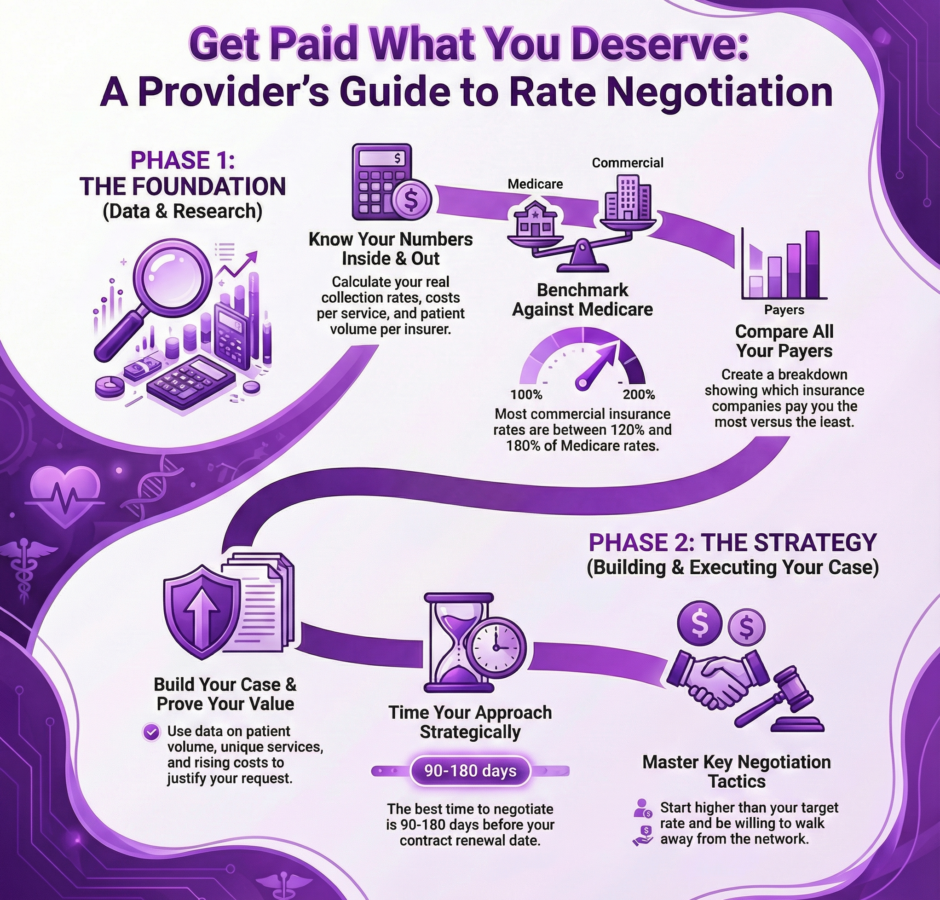Here’s an uncomfortable truth. Most healthcare providers are being underpaid by insurance companies.
Not because the insurance companies are evil, but because providers accept whatever rates are offered without pushing back. When you first join an insurance network, signing the contract and getting started feels easier than questioning the payment terms.

Yet, that decision to take the default rates can cost your practice hundreds of thousands of dollars over time.
Insurance reimbursement rates are almost always negotiable. Getting your financial house in order before entering these discussions can make the difference between barely breaking even and running a profitable practice.
Rate negotiations aren’t just for large hospital systems or corporate medical groups. Solo practitioners and small practices can and should negotiate better rates. The key is approaching these conversations with preparation, data, and confidence.
Insurance companies expect providers to accept their initial offers, but they also build flexibility into their rate structures specifically because they know some providers will negotiate.
Why Fighting for Better Rates Changes Everything
The reimbursement rates you accept from insurance companies directly determine your practice’s financial health.
These rates affect:
- How many staff members you can afford to hire
- Whether you can invest in new equipment or technology
- Your own take-home income as a provider
- Your ability to spend adequate time with patients
- Staff salaries and retention rates
- Resources for practice growth and improvements
Let’s look at real numbers. Consider a primary care physician who sees 25 patients per day, five days per week. If that doctor negotiates just a $10 increase per visit across their major insurance contracts, that adds up to $1,250 weekly or approximately $65,000 annually.
 For a small practice, that extra revenue could mean the difference between struggling to make payroll and having a healthy financial cushion.
For a small practice, that extra revenue could mean the difference between struggling to make payroll and having a healthy financial cushion.
The impact grows even larger for practices performing procedures or specialty services.
A dermatologist who negotiates a 15% rate increase on common procedures like biopsies and excisions might add $150,000 or more to annual revenue. An orthopedic surgeon negotiating better rates for joint injections and surgical procedures could see even more significant gains.
Beyond the immediate financial impact, better reimbursement rates affect your practice’s long-term viability. Adequate rates allow you to spend appropriate time with patients rather than rushing through appointments to maintain volume. They enable you to hire quality staff and keep them through competitive salaries.
They give you resources to invest in patient experience improvements and practice growth.

Step One: Know Your Numbers Inside and Out
Before you can negotiate effectively, you need to know your numbers inside and out.
Insurance companies have entire departments analyzing data and setting rates. If you walk into negotiations without solid financial information, you’re at a severe disadvantage.
What You’re Actually Collecting
Start by examining your real collection rates:
- Pull reports showing what you bill for your most common services
- Calculate what you actually collect after adjustments and denials
- Determine your effective reimbursement rate as a percentage of charges
- Identify variations between different insurance companies
Many practices are shocked to discover they’re collecting 40-50% of billed charges on average.
Compare All Your Payers
Create a breakdown showing reimbursement by payer. Which insurance companies pay you the most? Which pay the least?
You might find that one commercial insurer reimburses you at 150% of Medicare rates while another pays only 110% of Medicare. This information tells you where you have the most room for improvement.
Calculate Your True Costs
Know exactly what it costs you to deliver each service:
- Staff time for each appointment or procedure
- Supplies and materials used
- Equipment depreciation and maintenance
- Facility overhead (rent, utilities, insurance)
When you can demonstrate that an insurance company’s current rates don’t even cover your costs for certain procedures, you have a strong argument for increases.
Track Your Patient Volume
Insurance companies care about how many of their members you see. If you’re seeing 200 patients monthly from a particular insurer, you have more leverage than if you’re only seeing 20.
Step Two: Research What Others Are Getting Paid
You can’t negotiate effectively if you don’t know what fair reimbursement looks like.
Medicare: Your Starting Point
Medicare fee schedules provide a baseline for comparison. Most commercial insurance reimbursement is calculated as a percentage of Medicare rates.
Here’s your action plan:
- Research what Medicare pays for your most common CPT codes in your geographic area
- Calculate what percentage of Medicare your current contracts pay
- Know that commercial rates typically range from 110% to 250% of Medicare
- Recognize that most commercial rates fall between 120% and 180% of Medicare
If you’re currently at 115% of Medicare when similar practices in your area are getting 140% of Medicare, you have clear evidence that your rates are below market.
Where to Find Rate Data
Look at publicly available sources:
- CMS publishes physician fee schedules annually
- Some states require insurers to file rate information publicly
- Professional associations often conduct compensation surveys with reimbursement data
- Local medical societies sometimes have shared data among members
Connect with colleagues in your specialty and geographic area for general insights about which payers are “good” or “poor” payers.
Step Three: Build Your Case Like a Lawyer
You need to build a clear, data-supported argument for why the insurance company should pay you more.
Prove Your Value to Their Network
Show them the numbers:
- Patient volume data showing how many of their members you serve
- Patient satisfaction scores if you have them
- Your credentials and specialized training
- Unique services you offer that other providers don’t
- Evening or weekend hours that improve member access
Make Rate Disparities Impossible to Ignore
- Show how your current rates compare to Medicare benchmarks
- Provide regional average comparisons
- Compare rates from other payers you work with
- Create simple charts that make disparities crystal clear
Show Them Your Reality
- Detail rising costs for staff, supplies, rent, and malpractice insurance
- Show how margins have been squeezed over time
- Provide specific examples of procedures where you lose money at current rates
Step Four: Time Your Approach Strategically
When you approach rate negotiations matters almost as much as how you approach them.
The Best Times to Negotiate
90 to 180 Days Before Contract Renewal
This is the sweet spot. Start your rate negotiation conversation well before the renewal date, giving both sides time for discussion without pressure.
When First Joining a Network
Many providers assume they have no leverage when first credentialing with a plan. That’s wrong. You still have room to negotiate, especially if you have specialized skills or serve an underserved area.
During Major Practice Changes
These events create natural opportunities:
- Adding providers
- Expanding locations
- Adding new services
- Significantly increasing your patient capacity
When Network Dynamics Shift
If a major competitor in your specialty leaves their network, you suddenly have more leverage.
Timing to Avoid
Don’t wait until the last week before contract expiration. You lose leverage because the insurance company knows you probably won’t terminate the contract over rates.
Step Five: Master the Negotiation Dance
Request a meeting with the network contracting or provider relations department. Send your request in writing via email so you have documentation.
Strategies That Actually Work
Start Higher Than Your Target
If you ultimately want 150% of Medicare, ask for 165%. This gives you room to compromise while still reaching your real goal.
Prioritize High-Volume Services
Focus on what matters most. A 10% increase on codes you bill 1,000 times yearly is more valuable than a 20% increase on codes you bill 50 times yearly.
Request Retroactive Dates
If negotiations take months, ask for increases to be retroactive to your contract anniversary date or the start of negotiations.
Be Willing to Walk Away
This is your strongest leverage. Your willingness to leave the network if terms don’t improve shows you’re serious.
The insurance company will likely counter your initial request with something lower. This is expected, it’s negotiation. Don’t accept their first counter-offer immediately.
When Negotiations Hit a Wall
Sometimes despite your best preparation, rate negotiations hit roadblocks.
Your Options When Progress Stops
Put Everything in Writing
If verbal negotiations aren’t progressing, send a formal letter outlining your request, supporting data, and rationale.
Go Higher Up the Chain
If the initial contracting representative won’t move on rates, ask to speak with their supervisor or the director of network contracting.
Run the Numbers on Leaving
Calculate what percentage of your revenue comes from this payer and whether you could replace those patients from other sources. Sometimes walking away is the right business decision.
Give Proper Termination Notice
Most contracts require 90 to 180 days written notice before termination. Send this notice via certified mail and keep documentation.
After You Win: Protect Your Victory
Once you’ve negotiated new rates, get everything in writing before considering the negotiation complete.
Your Post-Negotiation Checklist
- Review the written agreement carefully before signing
- Verify that all negotiated terms are included
- Check the effective date matches what you agreed to
- Update your practice management system with the new rates
- Train your billing staff on the changes
- Monitor your payments closely after the effective date
- Compare actual reimbursement to contracted rates
- Address any discrepancies immediately
Insurance companies sometimes make mistakes implementing rate changes. Stay vigilant during the transition period.
Let Our Experts Fight for You
Many healthcare providers find rate negotiations stressful and time-consuming. You became a healthcare provider to treat patients, not to argue with insurance company contracting departments.
How Medwave Gets You Paid What You Deserve
Medwave provides payer contracting services designed specifically for healthcare providers who need expert support with insurance rate negotiations. We have extensive experience negotiating with major insurance carriers and know exactly what arguments and data resonate with their contracting departments.
Our Process:
- Conduct thorough analysis of your current contracts and reimbursement rates
- Compare your rates to regional and national benchmarks
- Identify the biggest opportunities for improvement
- Develop a prioritized negotiation strategy
- Prepare data and build the case for rate increases
- Manage all communication with insurance companies
- Work toward the best possible rates for your practice
We know when to push harder and when a particular insurance company has reached their limit. This experience helps us get better results than most providers can achieve on their own.
Complete Revenue Cycle Support
 Beyond rate negotiations, Medwave also handles credentialing and billing services, providing complete revenue cycle support. When you work with us for payer contracting, we can integrate those services with your overall billing operations to ensure smooth implementation of new rates and maximum revenue capture.
Beyond rate negotiations, Medwave also handles credentialing and billing services, providing complete revenue cycle support. When you work with us for payer contracting, we can integrate those services with your overall billing operations to ensure smooth implementation of new rates and maximum revenue capture.
If your practice is working with outdated reimbursement rates, struggling with low margins, or simply wants to ensure you’re being paid fairly for the care you provide, reach out today.
Let us help you get paid what you deserve through expert rate negotiations that support your practice’s long-term success and financial health.

